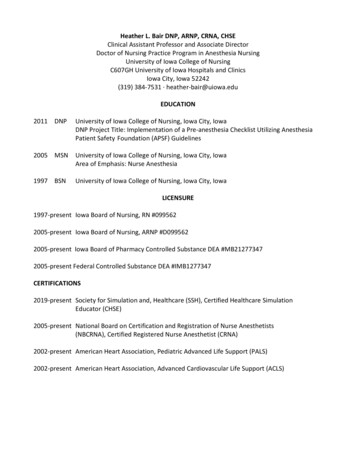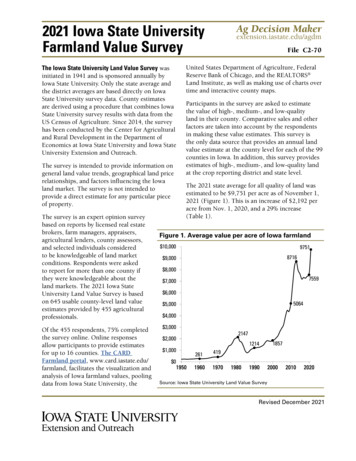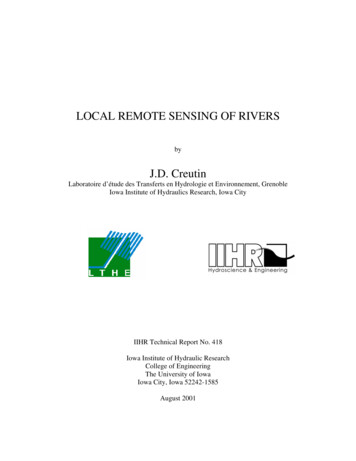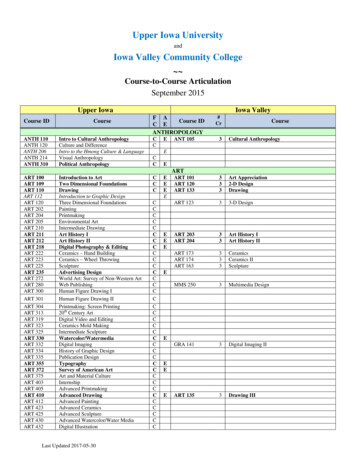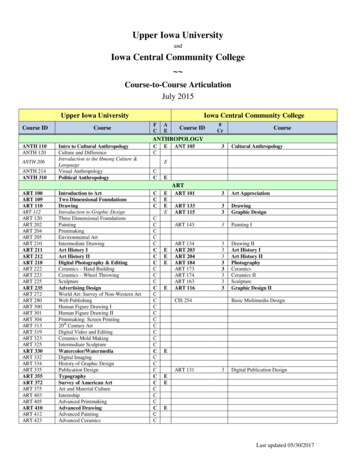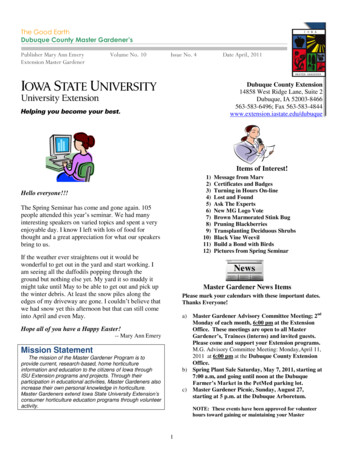
Transcription
The Good EarthDubuque County Master Gardener’sPublisher Mary Ann EmeryExtension Master GardenerVolume No. 10Issue No. 4Date April, 2011Dubuque County Extension14858 West Ridge Lane, Suite 2Dubuque, IA 52003-8466563-583-6496; Fax 563-583-4844www.extension.iastate.edu/dubuqueItems of Interest!1)2)3)4)5)6)7)8)9)10)11)12)Hello everyone!!!The Spring Seminar has come and gone again. 105people attended this year’s seminar. We had manyinteresting speakers on varied topics and spent a veryenjoyable day. I know I left with lots of food forthought and a great appreciation for what our speakersbring to us.If the weather ever straightens out it would bewonderful to get out in the yard and start working. Iam seeing all the daffodils popping through theground but nothing else yet. My yard it so muddy itmight take until May to be able to get out and pick upthe winter debris. At least the snow piles along theedges of my driveway are gone. I couldn’t believe thatwe had snow yet this afternoon but that can still comeinto April and even May.Message from MarvCertificates and BadgesTurning in Hours On-lineLost and FoundAsk The ExpertsNew MG Logo VoteBrown Marmorated Stink BugPruning BlackberriesTransplanting Deciduous ShrubsBlack Vine WeevilBuild a Bond with BirdsPictures from Spring SeminarMaster Gardener News ItemsPlease mark your calendars with these important dates.Thanks Everyone!Master Gardener Advisory Committee Meeting; 2ndMonday of each month, 6:00 pm at the ExtensionOffice. These meetings are open to all MasterGardener’s, Trainees (interns) and invited guests.Please come and support your Extension programs.M.G. Advisory Committee Meeting: Monday,April 11,2011 at 6:00 pm at the Dubuque County ExtensionOffice.b) Spring Plant Sale Saturday, May 7, 2011, starting at7:00 a.m, and going until noon at the DubuqueFarmer’s Market in the PetMed parking lot.c) Master Gardener Picnic, Sunday, August 27,starting at 5 p.m. at the Dubuque Arboretum.a)Hope all of you have a Happy Easter!-- Mary Ann EmeryMission StatementThe mission of the Master Gardener Program is toprovide current, research-based, home horticultureinformation and education to the citizens of Iowa throughISU Extension programs and projects. Through theirparticipation in educational activities, Master Gardeners alsoincrease their own personal knowledge in horticulture.Master Gardeners extend Iowa State University Extension’sconsumer horticulture education programs through volunteeractivity.NOTE: These events have been approved for volunteerhours toward gaining or maintaining your Master1
ISU is requiring that all hours will have to be reported online. In order to do this you will have to register on theMaster Gardener website, www.mastergardener.iastate.edu.It's easy to do. If you have any questions or need help withthis there will be people available to help you.There will be more information at our next MG AdvisoryCommittee Meeting April 11th. We will have a discussionand demonstration on what is the best way to implement thenew change. We will also be discussing what guidelines wewill use to approve volunteer and education hours, andimplementing deadlines for submitting hours.We should have more information to report after thismeeting.Gardener certification. Please contact Marv Stoffel at(563)582-4764 or by email at stoffel19@mchsi.com if youwant to be a volunteer at any of these events. Watch thisarea for more exciting events to come.From Marv Stoffel, PresidentMaster Gardener Advisory CommitteeSpring is officially here!! Many things in my yard andgarden are showing this. Spring flowers are popping up allover. What a refreshing time of year this is.Our Spring Seminar was a huge success. It was very wellattended and we had a lot of positive feedback. A great timewas had by everyone!! Thanks Cathy for chairing this event.Great job!! We are already making plans for next year. So, ifanyone has any ideas on speakers or topics please letCathy know.The next event will be the Spring Plant Sale. Mark yourcalendars for Sat. May 7th. This is a great time to startseeds and divide perennials to have them ready for ourMaster Gardener Plant Sale at Farmers Market in thePetMed parking lot.I know this can be a very busy time of year for everyoneso, the best advice I can give you is, "Enjoy each day andhave a Happy Spring".“Lost and Found”A yellow cloth napkin was left at Master GardenerSpring Seminar on a dessert plate. Please stop by theMaster Gardener Call Center to pick it up at your earliestconvenience.Ask the ISU ExtensionGardening ExpertsCertificates and Name Badges thatNeed to be Picked upThe following people need to stop in at the office andpick up their certificates and name badges from 2010 attheir earliest convenience –Certificate and Name Badges for new Master GardenersJudy NaumanLaura HoffmanWhat are snow peas?Snow peas are an edible podded pea. Snow peas areharvested when the pods are long and thin, just as theseeds begin to develop. Young pods are tender, stringlessand may be stir-fried in Chinese dishes, steamed or cookedlike snap beans. If the seeds are allowed to develop fully,they may be shelled and used like garden peas. Snowpeas are sometimes referred to as sugar peas.5 Year Service CertificateAlan ErnzenChris GibsonFrances Hedeman15 Year CertificateTerri StantonWhat are snap peas?Snap peas are an edible podded pea. Snap peas arebest picked when the seeds are nearly full size and the podwalls are thick, fleshy and crunchy. Snap peas may beeaten raw in salads, snapped and cooked like snap beans,or shelled for garden peas. They also freeze very well.Lifetime CertificateBernie CurranReinstated Members – Name BadgesDonna MartinRichard HendersenJean BledsoeDave RothMary RuelandWhen should peas be planted in the garden?Peas are a cool season crop. They should be planted assoon as the ground can be worked in spring (late March orearly April in central Iowa). Sow seeds 1 inch deep and 2inches apart. Peas can be planted in single or double rows.Space double rows 6 inches apart. Double rows allow shortvarieties to cling and hold up one another. Place wire nettingor a trellis between double rows of tall vining varieties toprovide support. Single and double rows of short varietiesHours Must Be Turned in toISU On-lineWe are changing the way that hours are reported thisyear.2
should be spaced 2 feet apart. Space single and doublerows of tall growing varieties 2 to 3 feet apart.To determine when to remove the mulch, periodicallyexamine the strawberry plants in spring. Remove the mulchfrom the strawberry planting when approximately 25 percentof the plants are producing new growth. New growth will bewhite or yellow in color. (If possible, the winter mulch onstrawberries should remain until mid-April in central Iowa.)When removing the mulch, rake the material to the aislesbetween rows. If there is a threat of a frost or freeze later inspring during bloom, lightly rake the mulch over thestrawberry plants.What are some good pea varieties for thehome garden?Suggested garden pea cultivars for home gardens inIowa include ‗Little Marvel‘(early season, short vines),‗Spring‘ (early season, shortvines), ‗Knight‘ (earlyseason, short vines),‗Lincoln‘ (mid to late season,very sweet), ‗Green Arrow‘(mid to late season, 24 to 28inch vines) and ‗Wando‘(mid to late season, heattolerant). ‗Oregon Giant‘(mid to late season, largepods), ‗Snowflake‘ (lateseason, flat pods) and‗Super Sugar Pod‘ (lateseason, long vines) are excellent snow pea varieties, while‗Sugar Ann‘ (early season, short vines), ‗Sugar Bon‘ (earlyseason, short vines), ‗Sugar Sprint‘ (early to mid-season,short vines), ‗Cascadia‘ (mid-season, short vines) and‗Super Snappy‘ (mid-season, large pods) are good snappeas.Uncovering hybrid tea rosesI placed soil around the base of my hybrid tea roses infall. When should I remove the soil?Remove the soil in late March or early April in southernIowa, mid-April in northern portions of the state. A frost orfreeze in early spring shouldn‘t harm the roses.After removing the soil, prune out any dead wood. Livewood is green and possesses plump, healthy buds. Deadwood is light to dark brown in color. When pruning, make thecuts about one inch below the dead, brown-coloredsections. Remove the entire cane if there is no sign of life.Ornamental grassesWhen should I cut back my ornamentalgrasses?Many ornamental grasses provide color, sound andmovement to the winter landscape. Because of these winterfeatures, cut back ornamental grasses in April in Iowa. Cutback the grasses to within 2 to 4 inches of the ground withhand shears, lopping shears or hedge trimmers.Do I need to treat my peas with an inoculantbefore planting?Peas are members of the legume (Fabaceae) family.Through a symbiotic relationship with a soil bacterium(Rhizobium), peas are able to ―fix‖ atmospheric nitrogen innodules on their roots.Peas will grow and produce a crop without inoculation.However, inoculation with a nitrogen-fixing bacterium maybe beneficial if peas have not been grown in the garden inthe past. Pea inoculants can be purchased at gardencenters and from mail-order catalogs. Inoculate pea seedsimmediately before sowing. Place a small amount of the peainoculant into the seed packet and shake.Dormant oil sprayWhen should I apply a dormant oil spray tomy fruit trees?Dormant oil sprays are highly refined petroleumproducts that are mixed with water and applied to trees andshrubs to control aphids, spider mites and scale. Dormantoils destroy pests by suffocating them. When appliedproperly, the thin film of oil plugs the spiracles or poresthrough which the mite or insect breathes.Proper timing is critical when using dormant oil sprays.Dormant oils should be applied in late March or early April inIowa before the trees show signs of breaking dormancy(before ―bud break‖). Dormant oils applied in February orearly March are not effective, as insects are not activelyrespiring at this time and, therefore, not vulnerable to theoil‘s suffocating effects. Dormant oil sprays should beapplied as close to bud break as possible.Removing strawberry bed mulchWhen should I remove the mulch on mystrawberry bed?To reduce the chancesof crop damage from a latefrost or freeze, leave themulch on as long aspossible. Removing themulch in March mayencourage the plants tobloom before the danger offrost is past. Temperaturesof 32 F or lower mayseverely damage or destroyopen flowers. Since the firstflowers produce the largestberries, a late spring frost orfreeze can drastically reduceWhen should I prune my shrubs?The proper time to prune deciduous and evergreenshrubs is determined by the plant‘s growth habit, bloom timeand health or condition.Spring-flowering shrubs, such as lilac and forsythia,bloom in spring on the growth of the previous season. Thehealth or condition of the plants determines the best time toprune spring-flowering shrubs.Neglected, overgrown spring-flowering shrubs oftenrequire extensive pruning to rejuvenate or renew the plants.yields.3
December, January and February – are the best time toprune oak trees.Large amounts of sap often flow from pruning cuts onmaple, birch and elm when pruned in late winter. However,the loss of sap doesn‘t harm the trees. The trees won't―bleed‖ to death. Eventually the flow of sap will slow andstop.The best time to rejuvenate large, overgrown shrubs is latewinter or early spring (March or early April). Heavy pruningin late winter or early spring will reduce or eliminate theflower display for two or three years. However, rejuvenationpruning will restore the health of the shrub.The best time to prune healthy, well-maintained springflowering shrubs is immediately after flowering. (Healthy,well-maintained shrubs should require only light to moderatepruning.) Pruning immediately after flowering allowsgardeners to enjoy the spring flower display and providesadequate time for the shrubs to initiate new flower buds fornext season.Summer-flowering shrubs, such as potentilla andJapanese spirea, bloom in summer on the current year'sgrowth. Prune summer-flowering shrubs in late winter orearly spring. Plants will still bloom in summer.Some deciduous shrubs don't produce attractive flowers.These shrubs may possess colorful bark, fruit or foliage.Prune these shrubs in late winter or early spring beforegrowth begins.Prune evergreen shrubs, such as juniper and yew, inearly to mid-April before new growth begins. Light pruningalso may be done in mid-summer.Raspberries and Trees and ProtectingServiceberriesPruning red raspberriesWhat is the proper way to prune „Latham‟ redraspberries in late winter?‘Latham‘ is a summer-bearing variety of red raspberry.Other popular summer-bearing red raspberry varietiesinclude ‗Boyne,‘ ‗Killarney,‘ and ‗Newburgh.‘ All summerbearing red raspberries should be pruned in the samemanner.In March or early April, remove all weak, diseased anddamaged canes at ground level. Leave the most vigorouscanes, those approximately one-fourth inch in diameterwhen measured 30 inches from the ground. After thinning,remaining canes should be spaced about six inches apart.Also, prune out the tips of the canes that have died dueto winter injury. Cut back to live tissue. If the canes havesuffered little winter dieback, remove the top one-fourth ofthe canes. Cane-tip removal or ―heading-back‖ prevents thecanes from becoming top heavy and bending under theweight of the crop.To obtain maximum yields, red raspberries should beconfined to a one- to two-foot-wide hedgerow. Shootsgrowing beyond the one- to two-foot-wide hedgerow shouldbe dug up and destroyed using a rototiller or spade.What is the best way to prune large,overgrown shrubs?Proper pruning can renew or rejuvenate overgrown,deciduous shrubs. One option is to prune the shrubs backover a three-year period. Begin by removing one-third of thelargest, oldest stems at ground level in late winter/earlyspring (March or early April). The following year (again inMarch or early April), prune out one-half of the remaining oldstems. Also, thin out some of the new growth. Retainseveral well-spaced, vigorous, new shoots and remove all ofthe others. Finally, remove all of the remaining old wood inlate winter/early spring of the third year. Additional thinningof new shoots should be done.A second way to prune overgrown, deciduous shrubs isto cut them back to within 4 to 6 inches of the ground inMarch or early April. This severe pruning will induce a largenumber of shoots to develop during the growing season. Inlate winter of the following year, select and retain severalstrong, healthy shoots and remove all others at ground level.Head (cut) back the retained shoots to encouragebranching. Overgrown lilacs, dogwoods, privets andforsythias may be pruned in this manner. (Most lilacsrejuvenated by this method will not bloom for two to threeyears.) This method is also an excellent way to renewscraggly potentillas and summer-flowering spireas. For bestperformance, potentillas should be cut back to within 3 to 4inches of the ground about every three years.Protect serviceberries from rabbitsI intend to plant several serviceberries thisspring. Will I need to protect them againstrabbits next winter?Rabbits are quite fond of serviceberries (Amelanchierspecies). If not protected, plants are likely to be damaged ordestroyed by rabbits during the winter months. Fencing(hardware cloth or chicken wire) is the best way to protectserviceberries and other woody plants from rabbits. Thefencing material should stand three feet above theground. (Rabbits eventually may be able to reach or climbover the tops of two-foot-tall fences in winters with frequentsnows.)About the Authors: Richard Jauron, Horticulture, 515294-1871 , rjauron@iastate.edu; Willy Klein, ExtensionCommunications and External Relations, 515-294-0662,wklein@iastate.eduPruning shade treesWhen is the best time to prune shade trees?February through March is generally regarded as thebest time to prune most deciduous trees. The absence offoliage at this time of year gives the individual a clear view ofthe tree and allows the selection and removal of appropriatebranches. Also, the walling-off or compartmentalization ofwounds occurs most rapidly just prior to the onset of growthin spring. Oaks are an exception. The winter months –4
North Carolina, Ohio, Oregon, Pennsylvania, Tennessee,Virginia and West Virginia. Detections have been made in ahandful of other states that now includes Iowa.BMSB feeds on sap from a long list of host plantsincluding many fruits, vegetables, field crops, shade treesand other woody ornamentals. In addition to theconsiderable damage done to crops, gardens andlandscapes, the adults have the disturbing habit of migratingto houses and other buildings in the fall to overwinter.Homeowners on the East Coast describe the stink buginvasion as worse than boxelder bugs and lady beetles,combined. It is this habit of spending the winter in buildingsthat has aided its dispersal by movement in containers andvehicles.The brown marmorated stink bug is approximately 5/8inch long with a mottled brownish grey color and a "shield"shaped body. The antennae and top of the abdominalsegments protruding from beneath the wings havealternating dark and light bands.Iowans are encouraged to help look for this pest and tocontact ISU Extension with sample specimens, digitalphotos or detailed descriptions and sightings. Please reportyour observations and samples to the ISU Plant & InsectDiagnostic Clinic.NEW! Mg Logo VoteBy Dr. Cynthia Haynes, Professor-in-Charge of the MGProgramThey say good things come to those who wait! I amhappy to report that the waiting is almost over for thoserequesting a new logo for the MG program in Iowa! Over thepast couple of years many MGs and administrators at ISUhave expressed concerns about our logo. It hasn't metUniversity guidelines and it is difficult to reproduce. While itis never easy to find a "new look" for a vibrant program suchas this one - we hope that we have come up with a fewoptions that capture our dynamic nature. Now we need yourinput - please select the logo you think best represents thespirit and dedication of Iowa MGs. Your votes will determinewhich logo is chosen to represent our program. While 2011will be our transition year to update banners, signs, evenapparel with the new logo that is chosen, both Jen and I arestressing that all old logos are still accepted. We want IowaMGs to wear their "basket" (1980-1998), "window pane"(1998-2011), or "new" logos with pride.The three options for the new Iowa MG logo are above.Please go to the website to cast your vote by April 15 go.htmlBrown Marmorated Stink BugDetected in IowaBy Laura Jesse and Donald Lewis,Plant & Insect Diagnostic ClinicThis article was published originally on 3/9/2011Adapted from an ISU Extension news release, February24, 20011.The Iowa State University Extension Plant and InsectDiagnostic Clinic (ISU-PIDC) and the Iowa Department ofAgriculture and Land Stewardship confirmed that a singledead specimen of the brown marmorated stink bug (BMSB),Halyomorpha halys, was recently collected in Cedar Rapids,Iowa and submitted to ISU-PIDC for diagnosis. This is thefirst confirmation of this pest in Iowa. It is not known if thisfind indicates an established population or an isolatedindividual as BMSB travels readily in shipping containersand with people.Brown marmorated stink bug was discussed anddescribed in the ISU Horticulture & Home Pest News,November 11, 2009.The brown marmorated stink bug is an introduced,invasive insect new to North America. It was first identified infall 2001 in Allentown, Pa.; though unconfirmed reports goback as far as 1996. The accidental introduction waspossibly via shipping containers from Asia. BMSB isreported to have established populations in California,Connecticut, Delaware, Indiana, Kentucky, Maryland,Massachusetts, New Hampshire, New Jersey, New York,Brown Marmorated Stink Bug. Note white bands onantennae and alternating bands on upper edge of abdomen.Brown Marmorated Stink Bug. Underside is light colored.5
Pruning BlackberriesTransplanting Deciduous ShrubsBy Richard Jauron, Department of HorticultureBy Richard Jauron, Department of HorticultureThe growth and fruiting characteristics of blackberriesare similar to raspberries. The blackberry plant's roots andcrown are perennial, while its stems or canes arebiennial. Blackberry canes are strictly vegetative during thefirst growing season. These first year canes are referred toas primocanes. The following year, these same canes (nowcalled floricanes) flower, produce fruit, and then die.In Iowa, the canes of most blackberry varieties sufferextensive winter injury. As a result of this damage, plantsproduce little or no fruit. However, there are two hardyvarieties that can be successfully grown in the southern halfof the state. 'Darrow' produces large fruit on vigorous, erect,thorny canes. 'Illini Hardy' bears medium-sized fruit. The fruitare produced on vigorous, erect, thorny canes.Primocane-bearing blackberry varieties (Prime-Jim and Prime-Jan ) are a new option for gardeners inIowa. Prime-Jim and Prime-Jan produce fruit in latesummer/early fall on the current year's growth. Fruit aremedium-sized, conical, soft, good flavored, and glossy blackin color.To obtain maximum yields, blackberries must be prunedproperly. Pruning procedures for summer-bearing andprimocane-bearing blackberries are provided below.Occasionally the need arises to move shrubs within thelandscape. Early spring (before growth begins) and fall (afterleaf drop) are the best times to transplant deciduousshrubs.Shrubs are best moved with a ball of soil adhering to theroots. With a portion of the root system intact, transplantingshock should be minimized with faster reestablishment.The soil should be moist when the shrub is dug. If thesoil is dry, thoroughly water the area 3 to 4 days beforedigging the plant.To make the transplanting process easier, wrap twinearound the shrub. Attach twine to the base of one of thestems, and then gently lift the stems upward and inward asthe twine is wrapped around the shrub. With the stemscompressed to a smaller area, it will be much easier to digand move the shrub.The radius of the root ball for deciduous shrubs shouldbe approximately one-half the distance from the dripline tothe center of the shrub. Dig a trench with a spade aroundthe plant to a depth of 12 to 15 inches. Then cut beneath theroots, rounding the bottom of the soil mass into a ball. Tipthe soil ball to one side, place a piece of burlap in the trenchon the opposite side, and then carefully lower the soil ballonto the burlap. Tightly wrap the burlap around the soilball. Lift and carry the plant by the root ball rather thangrasping the stems.If possible, replant immediately. Dig a hole that isapproximately twice the width of the shrub's root ball. Thedepth of the hole should be equal to the height of the soilball. Carefully lower the shrub into the hole, position itcorrectly, and begin to place soil back into the hole. Whenthe hole is about two-thirds full, cut away the top (exposed)portion of the burlap. Then complete the backfilling of thehole and water thoroughly.Home gardeners should limit themselves totransplanting deciduous shrubs that are 5 feet or less inheight. Root balls greater than 2 feet in diameter areextremely heavy and usually require mechanical equipmentto move the plants. Shrubs greater than 5 feet in height canbe moved by professionals with a tree spade.Summer-Bearing Blackberries ('Darrow' and 'IlliniHardy')In late winter or early spring, prune out canes that arediseased, damaged or crowded, leaving four to six healthycanes per plant. Also, prune back the lateral or sidebranches to a length of 12 to 15 inches to encourage largerfruit.In summer, pinch out or cut off the tips of the new caneswhen they reach a height of 36 inches. Pinching encouragesside branch growth and increases the fruiting surface area,resulting in higher yields. After the last harvest, cut off theold fruiting canes at the soil surface. Remove the prunedmaterial from the garden and destroy it.Primocane-Bearing Blackberries (Prime-Jim andPrime-Jan )Prune all canes back to ground level in late winter orearly spring. No additional pruning is necessary during theremainder of the year.Black Vine Weevil: UnusualAccidental Invader in IowaBy Donald Lewis, Department of EntomologyBlackberryplant showingprimocanes(first yeargrowth) andfloricanes(second year,fruitproducingcanes).Drawing fromUniversity ofIllinois.The recent arrival (March 3, 2011) of a digital image ofthe black vine weevil (BVW) collected from a kitchen floor inDelaware County was a reminder of just how uncommonthis insect pest in Iowa. The previous sample appears tohave been diagnosed back in 2006.Only a small handful of black vine weevils have beenidentified from only 9 Iowa counties in the ISU Plant andInsect Diagnostic Clinic. Almost all reports have come fromhomeowners who were bothered by the adult weevilsappearing as accidental invaders inside the home betweenOctober and March.Adult black vine weevils will feed on over 100 differentkinds of plants but prefer yews (Taxus) andrhododendrons. Taxus capitata seems to be particularlysusceptible to attack. Adult feeding causes small crescent6
shaped notches along the leaf margins. Iowa Department ofAgriculture & Land Stewardship nursery inspectors reportobserving occasional BVW leaf feeding damage oncontainerized rhododendron, yew, and sometimes azaleacoming from out-of-state, but there are no apparentindications of a large or ongoing problem in the state.Black vine weevils are oblong oval in shape, about 1/2inch long and have a short, broad snout with elbowedantennae. The body is slate gray to blackish brown and thewing covers have numerous small pits and patches of shortyellow hairs. See the photo below.Black vine weevil adults develop from white leglesslarvae that live in the soil under infested plants. The larvaefeed on young, tender roots. Leaf feeding by the adultsseems to have little effect on plant health. Heavyinfestations of larvae may cause stunting or death ofinfested plants. Only females are known in North America,and one generation occurs outdoors annually. They areeasily transported in potted plants or transplants using a soilroot ball.As mentioned, the black vine weevil has been troublingin Iowa as a harmless annoyance indoors after wandering infrom infested plants in the landscape. The black vine weevilcan not bite, sting or carry diseases. It does not feed on ordamage the house structure, its contents or occupants. It isonly a pest because of its presence. These weevils can notfly but they are very active walkers. They are most active atnight.Black vine weevils found indoors need only be swept orpicked up and discarded. Spraying is unnecessary andgenerally ineffective. Susceptible plants in the landscapeshould be watched for signs of weevil feeding in earlysummer. Treatment of infested plants in Iowa has not beennecessary to this date.Build a Bond with BirdsBy Jason Martin, NestWatchWhether in a shrub, a tree, or a nest box, bird nests areall aroundus. Bymonitoringa nearbynest youcan helpscientistsstudy thebiology ofNorthAmerica‘sbirds andhow itmight bechangingover time.Everyspring andsummer,Eastern Bluebird nest. Photo by J. Brindovolunteersfrom across the country visit nests and report their findingsto the Cornell Lab of Ornithology‘s NestWatch program. Asa NestWatcher, you keep tabs on bird family life, followingthe progression from incubated eggs, to fuzzy chicks, togawky youngsters ready to take their first fluttering flight. Allthe information you gather is submitted online to theNestWatch database.―NestWatch helps people of all ages and backgroundsconnect with nature,‖ says project leader Jason Martin. ―Theinformation that our dedicated citizen scientists collectallows us to understand the impact that various threats,such as environmental change and habitat destruction, haveon breeding birds. Armed with this knowledge, we can takethe necessary steps to help birds survive in this changingworld.‖Instructions andall the materials youneed to participateare available on theNestWatch websiteatwww.nestwatch.org.You‘ll also getdirections on how tofind and monitornests withoutdisturbing the birds.Eastern Bluebird chick hatching.It‘s fun, it‘s easy,Photo by Mary Thomsonand it‘s free.The Cornell Lab's immensely popular NestCams areback too. Cameras broadcast live video over the web fromthe nests of Barn Owls, bluebirds, wrens, Wood Ducks, andmany other species. Our newest camera is focused on aGreat Horned Owl family in Houston, Minnesota. Check itout at www.nestcams.org.And please join us for NestWatch this season—you‘llbuild a bond with birds and with nature in your ownbackyard.Black vine weevil adult. Photo by Cheri Hildebrand.7
Photos from the Spring SeminarSubmitted by Doug CheeverTicket numbers being drawn for some of the many doorprizes.Gardeners listen as Sara Carpenter gives her presentation.Clyde Holverson from Platteville, Wisconsin gave lots ofgreat tips on gardening and composting.Lunch is served.Steve Pregler, City Forester for the City of Dubuque, did apresentation of diagnosing tree problems and providing treecare advice.Sara Carpenter and her mother Sue Selchert gave apresentation on designing landscaping for homeowners andwhat we can expect in new garden items this season.Iowa State University and U.S. Department ofAgriculture Cooperating Extension programs areavailable to all without regard to race, color,national origin, religion, sex, age, or disability.8
‗Super Snappy' (mid-season, large pods) are good snap peas. Do I need to treat my peas with an inoculant before planting? hand shears, lopping shears or hedge trimmers. P eas are members of the legume (Fabaceae) family. Through a symbiotic relationship with a soil bacterium




